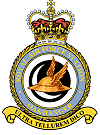RAF Oakhanger
RAF Oakhanger is a Royal Air Force station in Hampshire split over three operational sites; with accommodation in nearby Bordon.[3] The main site and operations centre is located near the village of Oakhanger, the two other sites being nearby. The parent station for administrative purposes was RAF Odiham.
| RAF Oakhanger | |
|---|---|
| Near Bordon, East Hampshire in England | |
 Satellite dish at Oakhanger | |
 | |
 RAF Oakhanger Location within Hampshire | |
| Coordinates | 51°6′55.31″N 0°53′36.5″W |
| Type | Military satellite communications station |
| Area | 55 hectares[2] |
| Site information | |
| Owner | Ministry of Defence |
| Operator |
|
| Condition | Closed |
| Site history | |
| Built | 1966 |
| In use | 1966–2003 |
| Fate | Operation of station transferred to the private sector under a private finance initiative contract. |
History
RAF Oakhanger was the home of No. 1001 Signal Unit,[4] responsible for supporting satellite communications services for the British Armed Forces worldwide. The unit was made up of four sub-units: Space Operations, Ground Operations, Telemetry and Control, and Support; with subordinate detachments based at RAF Rudloe Manor, RAF Colerne and RAF Defford. Command and Control of the system was conducted from Oakhanger, with a planning unit based at Rudloe Manor, co-located with No. 1 Signal Unit and Controller Defence Communication Network. The Colerne and Defford detachments provided a ground anchoring capability for the communications spacecraft. The Defford detachment was managed by the Defence Evaluation and Research Agency, later QinetiQ.
Space Squadron was responsible for flying a constellation of Skynet satellites, up to the fourth iteration of six space vehicles which supported Army, Royal Navy and Royal Air Force units. The space vehicles were controlled on a permanent basis from Oakhanger, with command and control traffic being passed from one of the three ground stations. Space Squadron also controlled the flight of space vehicles on behalf of NATO, with an earth station at the nearby NATO ground terminal. The constellation comprised geosynchronous satellites, providing Earth coverage and higher-power coverage over Northern Europe.
Ground services was responsible for routing traffic via the space vehicles, from a number of locations in the United Kingdom, to either stationary ground terminals such as Germany, Cyprus, Ascension Island and the Falkland Islands, or tactical ground terminals, mounted in ships or vehicles. Tactical terminals were operated by the Tactical Communications Wing, 30 Signal Regiment, 16 Signal Regiment, 249 (AMF(L)) Signal Squadron, 264 (SAS) Signal Squadron, or the Royal Marines Signal Squadrons.[5]
Current use
Support to British military satellite communications was outsourced to EADS Astrium's subsidiary company—Paradigm Secure Communications—in 2003, as a Private Finance Initiative. Paradigm Secure Communications is now known as Airbus Defence and Space.
RAF Oakhanger is now used to support the Skynet 5 constellation and the United States Space Force's Satellite Control Network.[6]
References
- Pine, L.G. (1983). A dictionary of mottoes (1 ed.). London: Routledge & Kegan Paul. p. 241. ISBN 978-0-7100-9339-4.
- "Defence Estates Development Plan (DEDP) 2009 - Annex A" (PDF). GOV.UK. Ministry of Defence. 3 July 2009. p. 34. Retrieved 19 November 2017.
- "RAF Oakhanger". Air of Authority - A History of RAF Organisation. Retrieved 18 May 2012.
- "Skynet 4 - Print".
- Kiralfy, R.J.C., Current issues for RAF Oakhanger and Number 1001 Signals Unit, Military Satellite Communications II (Ref. No: 1997/322), IEE Coilloquium on , vol., no., pp.5/1,5/6, 18 Nov 1997 URL: https://ieeexplore.ieee.org/document/659612
- "Oakhanger GSU, UK military support AFSCN". 18 July 2017.
